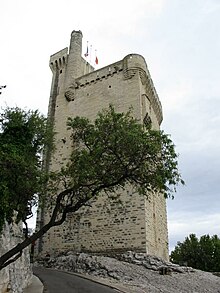Villeneuve-lès-Avignon
|
Villeneuve-lès-Avignon Vilanòva d'Avinhon |
||
|---|---|---|

|
|
|
| region | Occitania | |
| Department | Gard | |
| Arrondissement | Nîmes | |
| Canton | Villeneuve-lès-Avignon (main town) | |
| Community association | Grand Avignon | |
| Coordinates | 43 ° 58 ′ N , 4 ° 48 ′ E | |
| height | 10-181 m | |
| surface | 18.27 km 2 | |
| Residents | 11,698 (January 1, 2017) | |
| Population density | 640 inhabitants / km 2 | |
| Post Code | 30400 | |
| INSEE code | 30351 | |
| Website | Villeneuve-lès-Avignon | |
 Fort Saint-André |
||
Villeneuve-lès-Avignon (alternative spelling: Villeneuve-lez-Avignon; Occitan Vilanòva d'Avinhon ) is a municipality in the Gard department , Occitania region , southeast France , with 11,698 inhabitants (as of January 1, 2017). It is the easternmost commune of the Gard department and is located opposite Avignon on the right bank of the Rhône .
history
According to an epitaph , St. Casaria is said to have lived as a hermit in the 6th century in a grotto on Mont Andaon, in the northeast of today's city, and died on December 8, 586. A cult of saints developed around her grave . Later on, the Benedictine Abbey of Saint-André was founded on Mont Andaon at the place where, according to legend, Casaria is said to have lived . Saint Pons, Abbot of Saint-André, who died in 1087, was also venerated here.
When the French King Louis VIII was on his way to the Albigensian Crusade and was refused transit by Avignon, which was under the sovereignty of the Holy Roman Empire , in the summer of 1226 , he forced the city to surrender and traded with the abbot of Saint-André a treaty ( paréage ), according to which the abbot placed himself under his protection.
In 1292 Philip the Fair signed a new treaty with the abbot of Saint-André, which provided for the construction of a fortress and a tower opposite Avignon to protect the abbey on the then border of the kingdom. With the construction of the tower (Tour Philippe le Bel) near the Pont Saint-Bénézet , which began immediately, the king secured control of this Rhône bridge leading to Avignon and the associated income. In 1293 Philip the Fair also founded a royal bastide on the opposite bank of the Rhône from Avignon , which was initially called Ville Neuve-Saint-André-près-d'Avignon and received numerous privileges and freedoms. The new settlement was intended to compete with Avignon and outstrip this city, but the 1309 relocation of the popes to Avignon prevented such a development.
While Avignon was the capital of Latin Christianity, the popes and cardinals built magnificent palaces in Villeneuve, in which an artistic garden culture developed and which still shape the cityscape today. Cardinal Arnaud de Via , nephew of Pope John XXII. , founded the Collegiate Church of Notre-Dame here around 1330. In 1349 a treaty was signed in Villeneuve that brought Montpellier under the rule of the French king. In 1356 Pope Innocent VI founded here the Carthusian church of Notre-Dame-du-Val-de-Bénédiction, which became one of the largest and richest in Europe. Around 1360, King John II had the fortress built on Mont Andaon, which was already provided for in the treaty of 1292 and which was named Fort Saint-André. It was supposed to protect the Abbey of Saint-André from attacks by the feared hordes of mercenaries who wandered around in the Hundred Years War raging at the time, and also the border of the Kingdom of France. Even after the popes returned to Rome (1377), thanks to the privileges and the presence of wealthy monasteries, Villeneuve was able to maintain a certain level of prosperity.
Villeneuve remained relatively quiet during the French Revolution ; also many Avignonese found refuge here. But the city lost its royal city privileges and its rich monasteries; it sank to a canton capital. In the 19th century, the city became the preferred place of residence for wealthy Avignon citizens, who had a beautiful view of their city from here. This has remained the case to this day.
Population development
| year | 1962 | 1968 | 1975 | 1982 | 1990 | 1999 | 2006 | 2017 |
| Residents | 6422 | 6977 | 8540 | 9282 | 10,730 | 11,791 | 12,471 | 11,698 |
| Sources: Cassini and INSEE | ||||||||
Attractions
- Chartreuse Notre-Dame-du-Val-de-Bénédiction , 1356 by Pope Innocent VI. founded Carthusian monastery with church consecrated in 1358; The tomb of Innocent VI is located in one of the side chapels that were added later; In the course of the French Revolution, the complex was secularized and sold, and restored from 1909
- former collegiate church Notre-Dame, built at the beginning of the 14th century, with a rich marble altar and remarkable paintings
- Fort Saint-André , a fortress built in the 14th century on Mont Andaon with twin towers at the entrance, inside a Romanesque chapel and remains of the former Benedictine abbey of Saint-André
- Terrace gardens in the abbey, maintained by Benedictine monks until the French Revolution, were purchased in 1916 by the painter Gustave Fayet, who gave them to the poet friend Elsa Koeberlé and her partner Génia Lioubow, who restored the gardens together. An " Italian " and a " Mediterranean " garden spread out over an area of two hectares . The latter was designed from 1950 by Roseline Bacou, Fayet's granddaughter, including the remains of the Saint-André Abbey, the former cemetery and the foundations of St. Martin's Church.
- Tour Philippe-Le-Bel , fortified bridge tower built in the 14th century at the Pont Saint-Bénézet
Partnerships
Villeneuve-lès-Avignon is associated with through partnerships
- Rheinbach (Rhein-Sieg-Kreis) in Germany since 1969
- Peñíscola in the Valencia region of Spain since 1972
- San Miniato in Tuscany in Italy since 1992
- Gythio in the Peloponnese in Greece since 1997
Web links
- Official homepage (French, English)
Individual evidence
- ↑ Magical Gardens. The Saint-André abbey. ( Memento from March 12, 2018 in the Internet Archive ) In: arte.tv. Arte , accessed on March 11, 2018 - Description of the film for the documentary by Jean-Philippe Teyssier, director: Mathieu Despiau, France 2017, ARTE France , 26 min.

